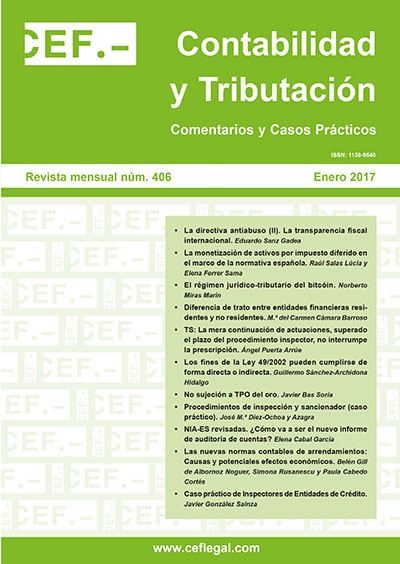Las nuevas normas contables de arrendamientos: Causas y potenciales efectos económicos
DOI:
https://doi.org/10.51302/rcyt.2017.4355Palabras clave:
arrendamientos, NIC 17, NIIF 16, IASB, FASB, cambios normativosResumen
La contabilidad de los arrendamientos es objeto de debate desde hace décadas. Las distintas posiciones se encuentran entre dos extremos: reconocer activos y pasivos en el balance o revelar información en las notas. Las normas vigentes en las últimas décadas establecen un modelo mixto, que obliga a clasificar los arrendamientos entre operativos o financieros, exigiendo para los primeros revelar información y para los segundos reconocer activo y deuda. Pero, fundamentalmente debido a las deficiencias detectadas en su aplicación práctica, en 2006 el IASB y el FASB comenzaron un proyecto conjunto para cambiarlas. El proceso, largo y no exento de polémica, finalizaba con la emisión de sendas nuevas normas a comienzos de 2016 (la NIIF 16 y la ASU 2016-02). El objetivo fundamental de este trabajo es explicar este proceso para ayudar a comprender las razones de este importante cambio normativo, así como sus potenciales efectos económicos. Es indudable que esto es necesario para evaluar la idoneidad de implementar este cambio en el modelo contable español.
Descargas
Citas
Alissa, W.; Bonsall, S. B.; Koharki, K. y Penn, M. W. [2013]: «Firms’ use of accounting discretion to influence their credit ratings», Journal of Accounting & Economics, 55(2-3), págs. 129-147.
Altamuro, J.; Johnston, R.; Pandit, S. y Zhang, H. [2014]: «Operating leases and credit assessments», Contemporary Accounting Research, 31(2), págs. 551-580.
Ang, J. y Peterson, P. [1984]: «The leasing puzzle», Journal of Finance 39(4), págs. 1.055-1.065.
Barral, A.; Cordobés, M. y Ramírez, J. [2014]: «Los arrendamientos operativos: impacto de su reconocimiento en los estados financieros y en la política de financiación de las compañías españolas y del Reino Unido», Revista de Contabilidad, 17(2), págs. 212-223.
Bennett, B. y Bradbury, M. [2003]: «Capitalizing non-cancelable operating leases», Journal of International Financial Management and Accounting, 14(2), págs. 101-114.
Caskey, J. y Ozel, B. N. [2015]: «Reporting and non-reporting incentives in leasing: Evidence from the airline Industry», Institute of Global Finance, Working Paper No. 3.
Collins, D. L.; Pasewark, W. R. y Riley, M. E. [2012]: «Financial reporting outcomes under rules-based and principles-based accounting standards», Accounting Horizons, 26(4), págs. 681-705.
Cook, D. C. [1963]: «The case against capitalizing leases», Harvard Business Review, 41(1), págs. 145-161.
Dechow, P.; Ge, W. y Schrand, C. [2010]: «Understanding earnings quality: A review of the proxies, their determinants and their consequences», Journal of Accounting and Economics, 50(2-3), págs. 344-401.
Deloitte [2011]: How prepared is your organization to cope with these new standards? A Deloitte survey on the FASB’s proposed changes to lease accounting standards.
– [2016]: NIIF 16 Arrendamientos. Lo que hay que saber sobre cómo van a cambiar los arrendamientos. Mantente actualizado. Grupo Técnico | IFRS Centre of Excellence, Febrero.
Demerjian, P. R. [2011]: «Accounting standards and debt covenants: Has the “balance sheet approach” led to a decline in the use of balance sheet covenants?», Journal of Accounting and Economics, 52, págs. 278-202.
Dieter, R. [1979]: «Is lessee accounting working?», The CPA Journal, 49(8), págs. 13-19.
Duke, C. J.; Hsieh, S. y Su, Y. [2009]: «Operating and synthetic leases: Exploiting financial benefits in the post-Enron era», Advances in Accounting, Incorporating Advances in International Accounting, 25(1), págs. 28-39.
Durocher, S. [2008]: «Canadian evidence on the constructive capitalization of operating leases», Accounting Perspectives, 7(3), págs. 227-256.
Financial Accounting Standards Board (FASB) [1976]: Accounting for Leases. SFAS No. 13. Disponible en: http://www.fasb.org/resources/ccurl/62/358/fas13.pdf
Financial Watch [2007]: Capitalization of operating leases by credit rating agencies. Different agencies use different methods, febrero.
Forbes [2005]: «Lease accounting gets uglier», 14 marzo.
Fülbier, R. U.; Silva, J. L. y Pferdehirt, M. H. [2008]: «Impact of lease capitalization on financial ratios of listed German companies», Schmalenbach Business Review, 60(2), págs. 122-144.
Gill-de-Albornoz, B. y Rusanescu, S. [2015]: «Capitalizando los arrendamientos operativos: el caso Inditex», I premio de casos prácticos para másteres en contabilidad y auditoría. ASEPUC.
Goodacre, A. [2003]: «Operating lease finance in the UK retail sector», International Review of Retail, Distribution and Consumer Research, 13(1), págs. 99-125.
Imhoff, E.; Lipe, R. y Wright, D. [1991]: «Operating leases: Impact of constructive capitalization», Accounting Horizons, 5(1), págs. 51-63.
– [1993]: «The effects of recognition versus disclosure on shareholder risk and executive compensation», Journal of Accounting, Auditing, and Finance, 8(4), págs. 335-368.
International Accounting Standards Committee (IASC) [1982]: IAS 17: Leases.
International Accounting Standards Board (IASB) [2007]: History of lease accounting. Information for observers. Board Meeting: 22 March. Project: Leases. Agenda paper 12C.
– [2015]: Snapshot: Conceptual Framework for financial reporting. Exposure draft, May.
IASB/FASB [2010]: Exposure Draft 2010/9: Leases.
– [2011]: Comment letter summary. Staff paper. Agenda paper 5A/FASB memo 123.
– [2013]: Snapshot: Leases of ED/2013/6.
Jaafar, A. y McLeay, S. [2007]: «Country effects and sector effects on the harmonization of accounting policy choice», Abacus, 43(2), págs. 156-189.
Leone, M. [2010]: «Taking the “ease” out of “lease”?», CFO, 26(10), págs. 52-55.
Lim, S. C. [2014]: «The information content of disaggregated accounting profitability: Operating activities versus financing activities», Review of Quantitative Finance & Accounting, 43(1), págs. 75-96.
McGregor, W. [1996]: «Accounting for leases: A new approach», Stamford, CT: Financial Accounting Standards Board.
Monson, D. W. [2001]: «The conceptual framework and accounting for leases», Accounting Horizons, 15(3), págs. 275-287.
Mulford, C. y Gram, M. [2007]: «The effects of lease capitalization on various financial measures: An analysis of the retail industry», Journal of Applied Research in Accounting & Finance, 2(2), págs. 3-13.
SEC [2005]: Report and recommendations pursuant to Section 401(c) of the Sarbanes-Oxley Act of 2002 on arrangements with off-balance sheet implications, special purpose entities, and transparency of filings by issuers, Washington, DC.
Smith, C. W. y Wakeman, L. M. [1985]: «Determinants of corporate leasing policy», The Journal of Finance, 40(3), págs. 895-908.
















